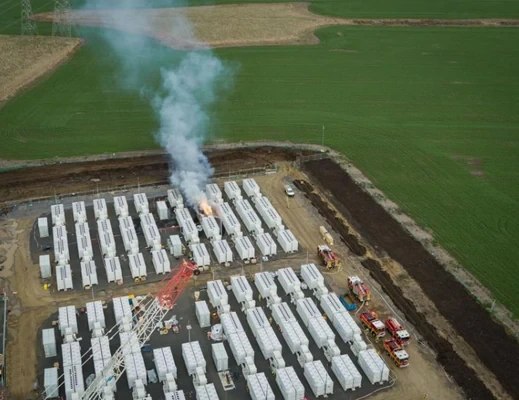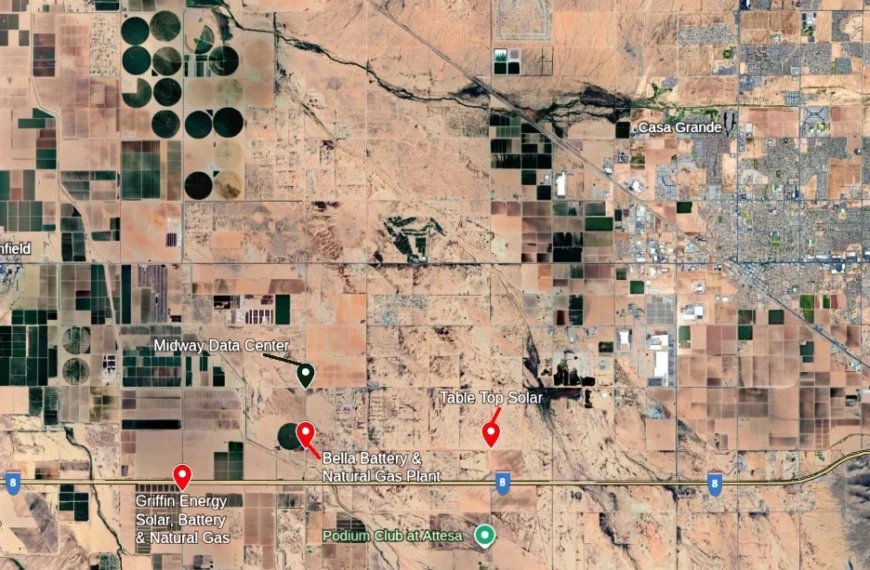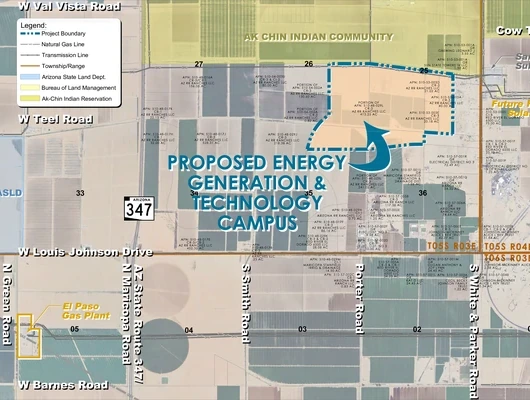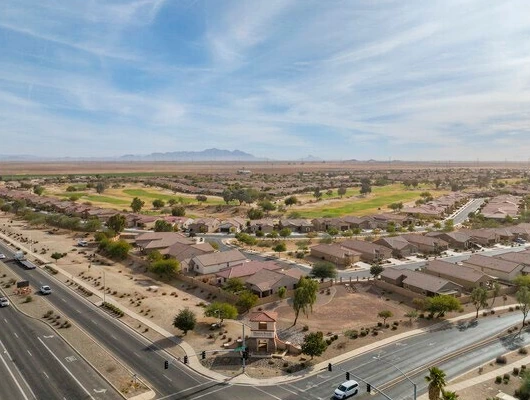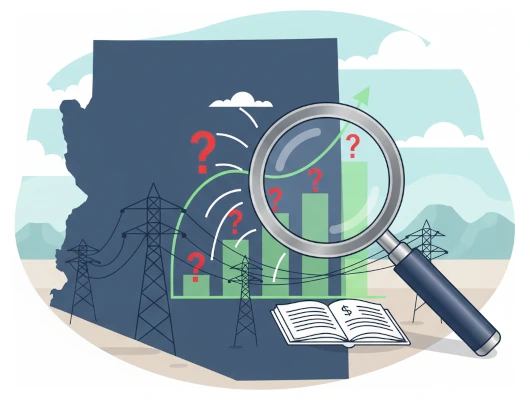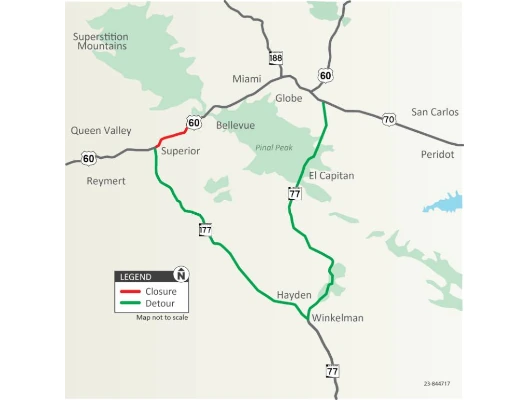Pinal County supervisors heard a detailed presentation on Battery Energy Storage System safety during their November 12, 2025 work session. James Caulfield, Senior Fire Protection Consultant with Fire & Risk Alliance LLC, addressed common concerns about battery fires, evacuations, and environmental impact.
Agenda Item Connects to Epic Star Energy Project
The presentation was listed as an information-only item on the Board of Supervisors agenda. Supervisor Rich Vitiello requested the presentation as an independent assessment of battery storage technology.
Fire & Risk Alliance, LLC is a fire protection and risk management firm that provides consulting services for battery energy storage facilities. The company is not affiliated with any specific battery storage manufacturer. Epic Star Energy brought Fire & Risk Alliance to present to the Board of Supervisors. The presentation title slide identified Epic Star Energy, and Caulfield stated, “Epic Star has kind of brought us out here.”
Epic Star Energy recently proposed a natural gas plant and battery energy storage facility near Hidden Valley. The White Plains, New York-based company held two community meetings about their project at the Pinal West Substation site near Table Top and Fulcar Roads, according to inMaricopa. The first meeting occurred October 27, 2025 at Raceway Bar and Grill. The second meeting took place November 12, 2025 at Elements Center. Epic Star Energy is a portfolio company of Fortistar, a private investment firm focused on energy and industrial projects.
Supervisor Explains Technology Improvements
Vitiello told fellow supervisors why he arranged the presentation. “There’s a misconception that the world’s gonna be on fire with these battery storages,” he said. He noted that older systems from many years ago experience fires. However, he stressed that technology has improved significantly.
“The systems are getting better and better, and the safety’s getting better and better,” Vitiello said. He acknowledged his own perspective had evolved. “Back 10 to 12, 15 months ago, I was probably a no. And now today, based on what I see out there, I see storage systems are getting better and better,” he added.
Response Perspective Favors Battery Storage Over House Fires
Caulfield, a 22-year veteran of law enforcement and fire service, presented what he called a “home run” response scenario. “From a firefighter’s perspective, for me, this is a home run of a response, because I’m seeing the same three pieces of equipment over and over,” he explained. “I’m seeing the container, I’m seeing an inverter, and I’m seeing a transformer.”

He contrasted this with residential responses. “If I go out to a call for service, whether it’s in a commercial area or whether it’s a residential area, I don’t have a blueprint of the house. I don’t know what I’m walking into,” Caulfield said. “So every home, every response is always different.”
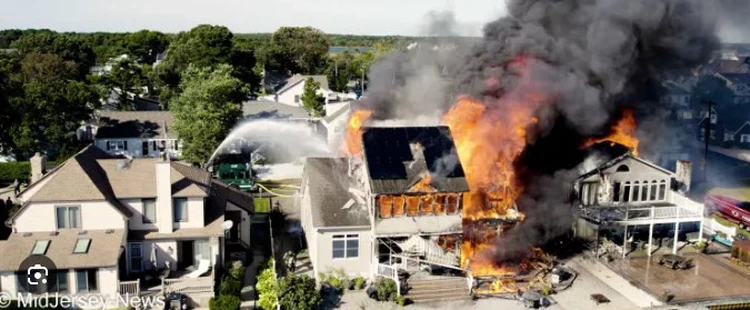
At battery storage facilities, the response remains consistent. “I know exactly what I’m looking at. My response doesn’t change. I know exactly what we’re gonna do, how we’re gonna set up essentially keeping all the members safe,” he stated.
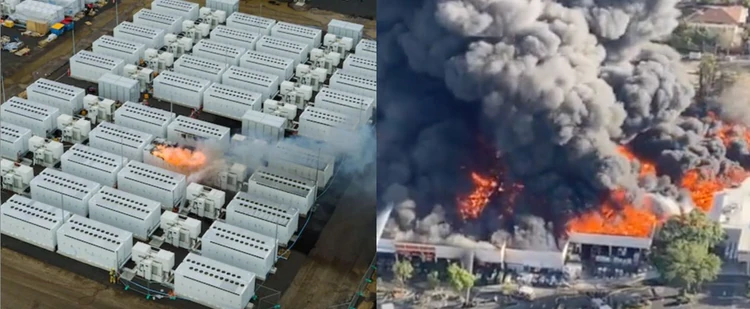
Technology Advances Since Moss Landing 2020 Installation
Caulfield highlighted the Moss Landing incident to demonstrate industry evolution. The equipment at Moss Landing was installed in 2020 with technology and standards that have since evolved. He described Moss Landing’s size by saying “take three or four Home Depots, put them next to each other. That’s how big Moss Landing was.” The facility featured an open design with single rooms and no fire breaks.

Modern containers measure approximately 24 by 9 feet. They are separated units with no expectation for anyone to enter. “Technology continues to improve, it continues to get safer,” Caulfield noted. He compared battery technology evolution to cellphone improvements that occur annually.
EPA Findings Show No Public Health Risk at Moss Landing
The Moss Landing fire began on January 16, 2025. EPA air monitoring for hydrogen fluoride and particulate matter from January 17-20 showed no risk to public health. The EPA concluded supplemental air monitoring on January 20, 2025. “Smoke from the facility has greatly diminished,” EPA stated in its release.
The EPA continues to oversee the Moss Landing response, working with Vistra to safely remove and dispose of batteries impacted by the fire.
Caulfield emphasized this data during his presentation. “These aren’t my findings, but I like to do the homework for everyone, and then I welcome you guys to do your homework as well” he said.
Water Intrusion Testing Addresses Rain Concerns
Two separate incidents in New York State and Idaho occurred during rainy conditions. These events prompted discussions about water exposure to battery containers. The industry now uses IP66 ratings for enclosures.
Caulfield explained the testing process. “We flowed 1,600 gallons per minute of water for 20 minutes and there was no intrusion of water,” he said. He compared it to dropping a phone in a toilet. “If you ever went to use the restroom and you dropped your phone in the toilet and you pick it up and it still works, that’s what IP66 means,” he explained.
Chairman Stephen Miller asked whether testing is required on every installation. Caulfield confirmed that testing occurs at multiple levels. “Module, cell, rack, and container,” he said. “There are multiple levels of testings that has to be passed and approved before they manufacture it.”
House Fire Comparison Reveals Higher Unknown Risks
The discussion between Vitiello and Caulfield explored what burns in different fire scenarios. Caulfield posed a relatable question. “What do I keep in the two-car garage?” he asked. “Everything that your wife or your spouse doesn’t let you keep in the house.”
He listed typical garage contents. “I have lawn fertilizer, I have kerosene for the heater, I have gasoline for the lawnmower, I have my aerosols. I have about six cans of paint,” Caulfield said. The list of unknown chemicals and plastics continues in every home.
“When I go to a house fire, I don’t know what’s burning. I don’t know what’s in the house,” he stated. “When I go to a battery energy storage fire, I know exactly what I’m dealing with.”
Evacuation Discussion Highlights Public Perception Gap
Caulfield made a pointed observation about public behavior during fires. He referenced the house fire photo shown in his presentation. “You know where people are standing when this fire is occurring? Across the street,” he said. “And they’re taking their phones out and they’re recording it, because that’s what people do.”
He drew a stark contrast. “So they don’t want to evacuate for a house fire, but people want to evacuate seven miles for a battery energy storage fire,” Caulfield stated. He emphasized the need to understand actual risks versus perceived dangers.
Peoria Fire Image Shows Water Management Approach
Supervisor Jeff Serdy asked about a recent fire in the Phoenix area. Caulfield confirmed he was aware of the Peoria incident. “The video that I had showed you, that was actually from Peoria,” he revealed. The investigation was not yet complete at the time of the presentation.
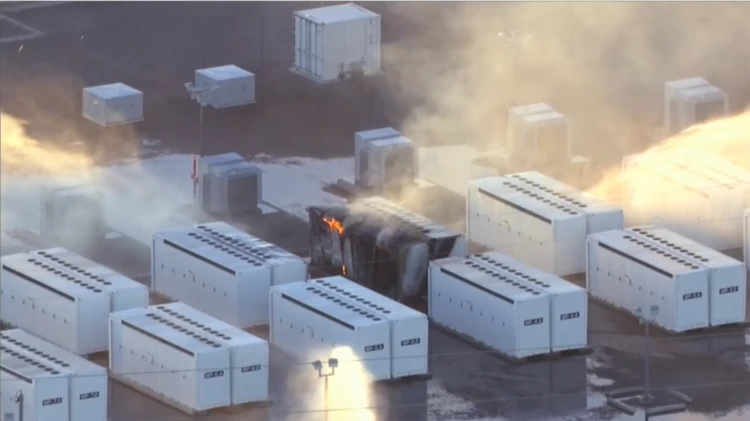
The Peoria video showed a BESS container being managed with water. Caulfield explained the modern response approach. “The amount of water being applied here is no longer the response tactic,” he said. Current protocols call for intermittent water application to adjacent containers. “We’re going to maintain a safe standoff distance, monitor the temperatures of the adjacent containers, and we’re just going to keep them cool,” he explained.
Class A Versus Class C Fires Prevent Ember Production
Caulfield addressed wildfire concerns by explaining fire classifications. House fires are Class A fires that can produce embers. These embers can travel and start fires in other locations.
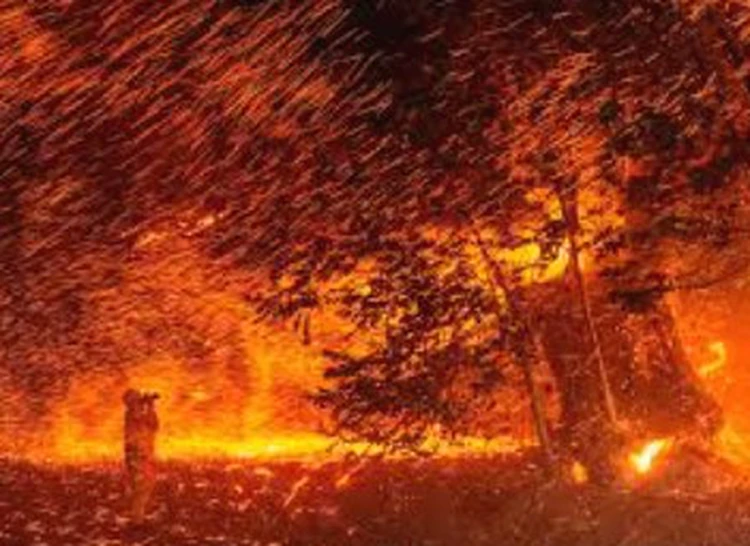
Battery storage fires are Class C fires. “There’s no embers,” Caulfield stated clearly. Vegetation management and codes ensure proper spacing at BESS facilities. “There is no embers that are produced at the highly unlikely event there was to be a fire at one of these facilities,” he emphasized.

Escondido Fire Data Shows Minimal Fence Line Toxin Levels
Caulfield presented detailed air monitoring data from an Escondido battery fire. A large area was evacuated or ordered to shelter in place during the incident. The pink area around the facility was ordered to evacuate. The purple area was ordered to shelter in place. “That’s a very large area. That’s a very large incident to try to manage, and that’s a very big strain on resources,” he said.
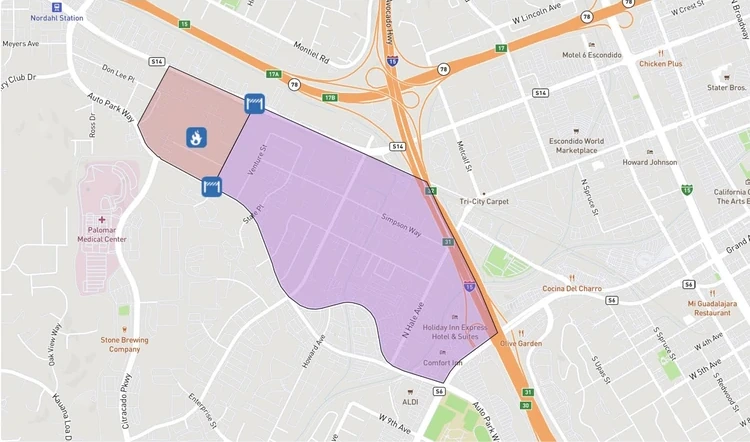
However, the actual measurements told a different story. “This decision was made off of fear and emotion, not facts and data,” Caulfield stated. Testing at the fence line recorded only two parts per million of hydrogen cyanide. “Now, that sounds absolutely terrible,” Caulfield acknowledged. However, he provided context. “Hydrogen cyanide is burning plastic. It’s also found in cigarette smoke,” he explained.
He emphasized the distance factor. “The further you move away from any type of fire or event or incident, very similar to what those gases do in a traffic jam, they rise and they dissipate,” Caulfield said. The Escondido air quality report contains the complete data from the incident.
Post-Fire Water and Plume Analysis Shows No Harmful Toxins
Caulfield presented findings from third-party testing conducted after the Escondido fire. Air monitoring, surface sampling, and water quality tests were performed. “There were no harmful toxins found,” Caulfield reported. He provided data from the California Energy Storage Alliance and welcomed supervisors to review the public findings themselves.
Soil Testing After Chaumont and East Hampton Events
Caulfield addressed soil contamination concerns by presenting data from two incidents. He provided the board with information on the Chaumont Battery Fire and East Hampton BESS 24-hour deluge, both of which involved extended water application.
Caulfield also referenced Governor Hochul’s working group findings from multiple New York battery fires. The data included air monitoring, soil sampling, and water analysis. “No harmful levels of toxins detected at the site of the battery storage fire,” the report stated. Testing showed no evidence of offsite migration of contaminants.
Gateway BESS Fire Required Six Million Gallons
The Gateway BESS fire in California presented unique challenges. The EPA directed the fire chief to contain all water used during the incident. “So not only did the chief do a phenomenal job by keeping the members safe, managing the incident, he contained six million gallons of water,” Caulfield said.
Modern response tactics would not use such volumes. However, the Gateway incident provided valuable data. “The EPA tested it. The results and their findings, that water was released back into the community, ’cause there was nothing found,” Caulfield reported.
He summarized the implications. “Our response tactic today is, we are not using an overwhelming amount of water. But what we’re seeing in, and from the data and the facts that are being provided to us, we’ve tested the soil, we have findings, wasn’t harmful,” he stated.
Remote Locations Reduce Response Complexity
Serdy summarized his understanding of the presentation. “When these battery storage are remote, there’s really no danger to any nearby houses. Just let ’em burn out, just protect the other ones from catching fire,” he said. Caulfield confirmed this assessment from a firefighter’s perspective.
The supervisor continued his analysis. “The people that might be at risk are people that cover their roof with solar and put a big battery in their house. Those are the folks that are probably more at risk than doing these remote battery storages,” Serdy observed.
Vice Chairman Jeff McClure asked about fire duration. Caulfield explained that burn time depends on the state of charge. “If you look at your cellphone and you have 20%, there’s not a lot of energy left. If you look at your phone in the morning, you wake up, it’s at 100%,” he compared.
Firefighters can check energy levels when they arrive. “They’re gonna be able to understand, is this a longer incident? Is this a shorter incident?” Caulfield said. “Unfortunately, there is no direct answer because it’s very specific to how much energy’s actually currently stored in that battery.”
The Board of Supervisors took no action on the information-only presentation. Supervisor Mike Goodman thanked Vitiello for arranging the briefing. “Very informative,” he said. Epic Star Energy’s project still requires rezoning and comprehensive plan amendments from both the Planning and Zoning Commission and Board of Supervisors before moving forward.
